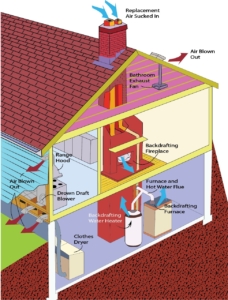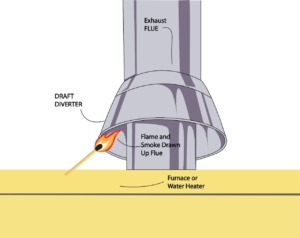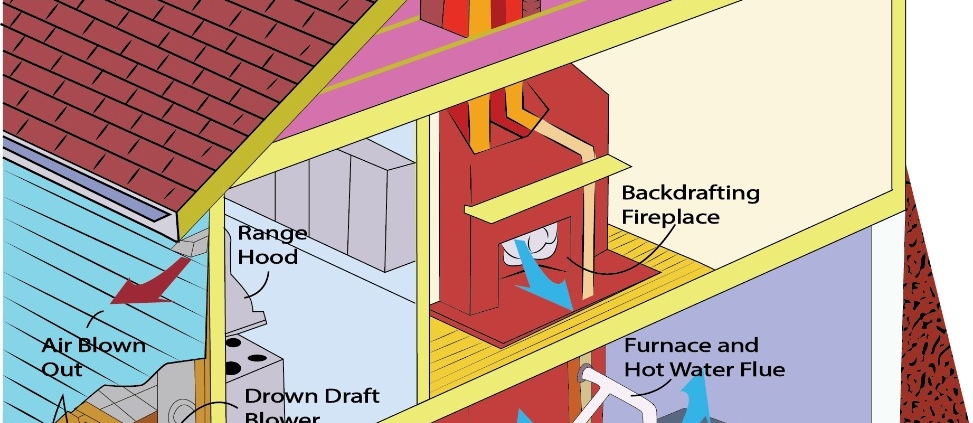Exhaust Vent Back-Drafting
Exhaust vent back-drafting has become a common concern for homeowners with the increasing usage of fuel-fired heating appliances in their homes. Back-drafting is the result a reversed flow of combustion by-products back into the home. Many fuel-fired home appliances like water heaters and furnaces burn fuel and produce combustion gases. If these by-products are not properly vented, this can cause the exhaust to be pulled back into the home.
When this happens, there is a possibility of the occupants becoming exposed to lethal combustion gases. So, it is quite clear that back-drafting poses potential hazards for the residents. And this is probably the reason why home inspectors search for evidence of back-drafting during home inspections. Being a matter of concern, we should discuss when this problem happens and how it can be resolved.
How does Back-Drafting Happen?
A flue plays a key role in exhausting the combustion by-products produced by fuel-fired home appliances like water heaters, furnaces, boilers, and wall heaters. Due to their lower density than the indoor air, these combustion gases rise through the flue and escape the home.
An improperly configured flue is often the culprit for exhaust gases back-drafting into the home. The flue vent should travel vertically for a minimum of 12 inches before an elbow or turn is installed. The exhaust vent should always have an upward slope leading the gases up and away from the appliance. The slope should be least ¼ inch per foot. Furthermore, there should not be any dips or sags in the vent. This vent angle provides a good drainage angle for condensing units and creates a strong updraft that can pull in hot air from the appliance.
Any blockages or narrowing of the flue can cause the flow of exhaust gases to slow down and accumulate within the home. This is part of the reason for why its important to have your HVAC system regularly serviced and cleaned.
Back-drafting can also occur as a result of the fuel fired appliance being located in a confined space without a sufficient amount of make-up air which is also referred to as combustion air. The flame produced by the appliance requires oxygen to maintain combustion and produce heat. Having enough make-up air will limit the chances of the house becoming depressurized. If depressurization happens the flame will attempt to pull in oxygen from outside the home through the exhaust vent which will result in back-drafting.
Depressurization (i.e., very low air pressure indoors) can also occur when a large amount of air is expelled to the outdoors through exhaust fans, fireplaces, and dryers, especially in air-tight homes. As a result, the release of combustion gases can be affected, and combustion gases can be drawn back into the home, causing danger to occupants.

How to Identify Back-Drafting?
There are various ways to detect exhaust vent back-drafting. One easy way to identify whether back-drafting happens is by installing a CO detector. This device detects the level of carbon monoxide in a home and sounds the alarm in case the carbon monoxide level rises above a certain level.
Another way to detect back-drafting is to place an ignited incense stick near the exhaust vent. If the smoke passes up through the vent, the system is venting properly. But if the smoke does not pass through the vent, there is a possibility that back-drafting is occurring.

Scorch marks and corrosion can also be indications of back-drafting. However, even without evidence of back-drafting, it is important to eliminate any underlying contributors to back-drafting as early as possible. For this reason, we advise homeowners to hire a professional to perform the maintenance job of fuel-fired home appliances at least once a year.
What to Do If You have Back-Drafting?
If you are quite sure that your fuel-fired heating appliance is leaking exhaust gas into the home, we urge you to take this very seriously. Improving the ventilation system can be the immediate step to get rid of this problem. You can open the windows of your home to allow the outdoor air to come in or even run the nearby exhaust fan to release the exhaust gases from the home.
Of greater important is for you to contact an experienced HVAC technician to determine the root cause of the back-drafting and correct it.




